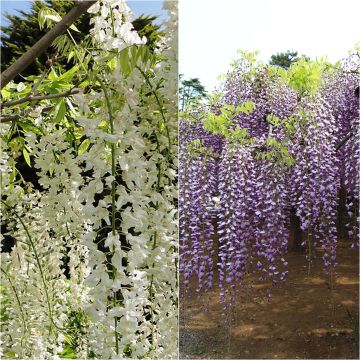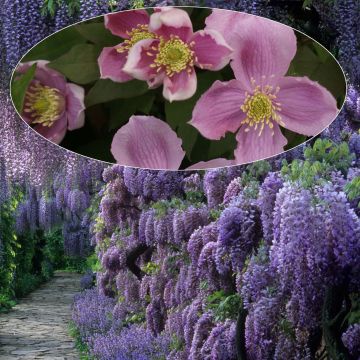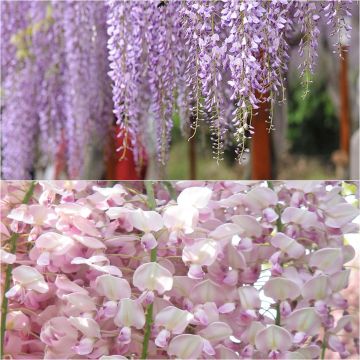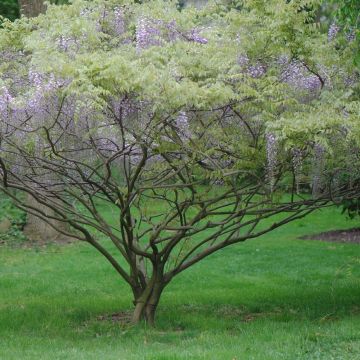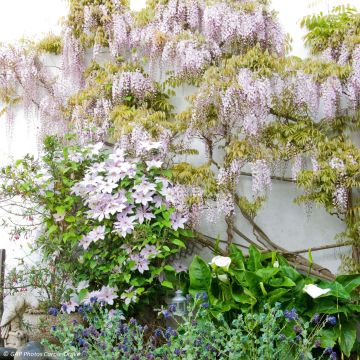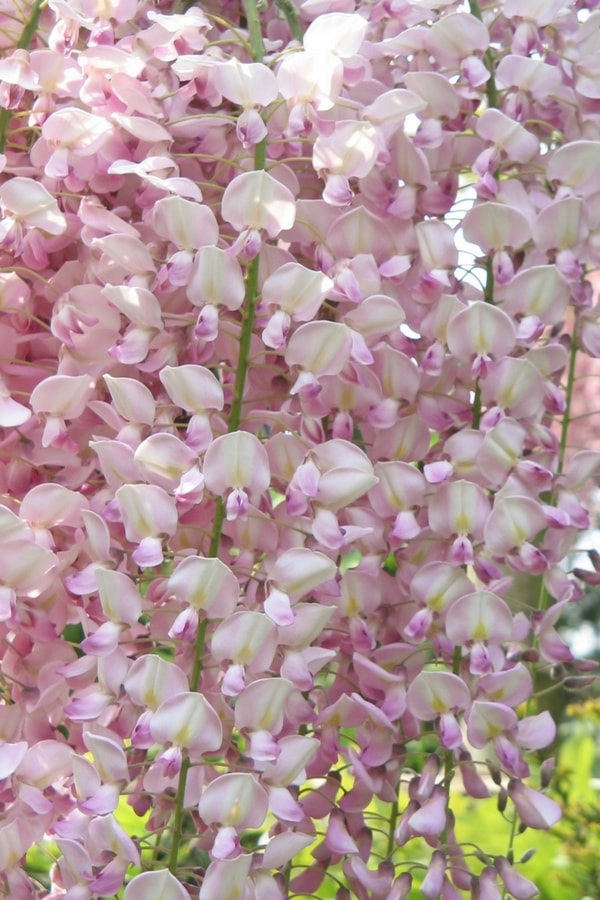
Wisteria: how to plant, prune and care?
Contents
In a nutshell
- Wisteria offers, in spring, a very abundant and fragrant flowering, in shades of blue, mauve or white. It can sometimes bloom again during summer!
- Particularly vigorous, it is easy to cultivate and grows quickly! It just requires a bit of pruning to manage its growth.
- Often grown in the ground, it can also adapt to pot cultivation!
- Its finely cut, light green foliage will charm you with its light and delicate appearance!
- With their flowering in long trailing clusters, the Chinese Wisteria (Wisteria sinensis) and Japanese Wisteria (Wisteria floribunda) bring a lot of romance to arbors and pergolas!
A word from our Expert
Very popular, the Wisteria surprises us with its exuberance! It is a majestic plant, whose abundant flowering always creates a sumptuous display when it cascades over an arbour or pergola. It blooms in spring, starting from April or May, and sometimes offers a second flowering in summer. It is also appreciated for its finely cut compound foliage, light green in colour. It provides a lush vegetation that has the ability to enhance old stone houses and give them a lot of charm!
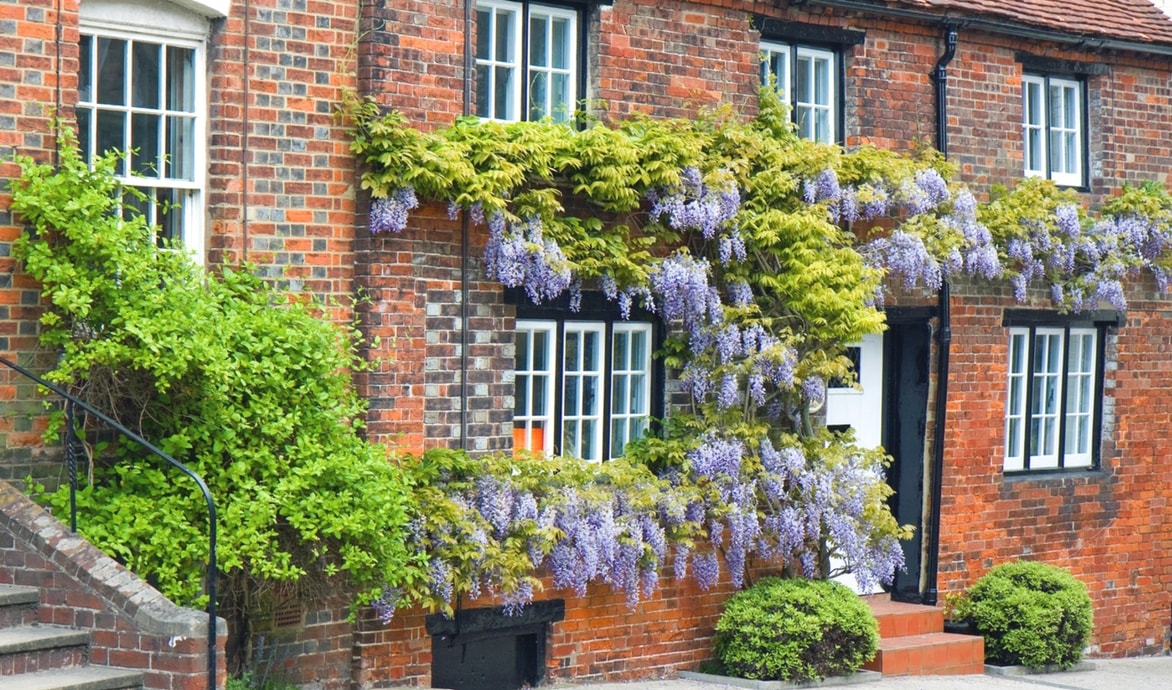
Easy to cultivate, it enjoys well-drained and cool soils but is sensitive to calcareous grounds, which can lead to chlorosis. Plant it in full sun! It is hardy and relatively resistant to pests and diseases. Once established, it grows on its own but requires some pruning to control its growth and prevent it from turning the garden into a jungle! Very vigorous and powerful, it can twist the supports on which it grows. It can live for a long time and form a beautiful twisted trunk. It is one of those plants that assert themselves and become monumental over the years.
Finally, as it occupies only a very small space on the ground, it is an ideal plant for the city. A single plant can create a stunning garland that will light up in spring and attract all eyes.
In gardens, you will mainly find the Chinese Wisteria (Wisteria sinensis) and the Japanese Wisteria (Wisteria floribunda). However, there are many varieties, some of which have double flowers! They can be associated with other climbing plants but are very beautiful as a standalone specimen. It is even possible to highlight them by training them as a tree. They multiply very easily by layering.
Botany and description
Botanical data
- Latin name Wisteria sp.
- Family Fabaceae
- Common name Wisteria
- Flowering Between April and June
- Height up to 15 metres
- Exposure full sun
- Soil type cool and well-drained
- Hardiness -15 to -20 °C
Wisteria is a climbing plant, a true liana! It climbs using its voluble stems, which wrap around the support. In nature, its “supports” are trees or cliffs. It is native to Asia: China, Japan, and Korea, as well as the United States for Wisteria frutescens. Wild Wisteria sinensis can be found at the forest edges in western China.
Although there are about ten species of Wisteria, in cultivation, we mainly find Chinese Wisteria (Wisteria sinensis) and Japanese Wisteria (Wisteria floribunda). Wisteria belongs to the very large family of Fabaceae, which includes many useful and edible plants, such as beans, broad beans, soybeans, and clovers! It also includes ornamental plants like Mimosas, Cytises, and Lupins.
Wisteria is very vigorous and grows quickly: it is not uncommon for its stems to extend more than a metre in a year! Japanese Wisteria grows by wrapping around the support in a clockwise direction, while the opposite is true for Chinese Wisteria.
It reaches a spectacular size when mature, up to 15 metres high and 10 metres wide. Exceptionally, rare specimens can reach lengths of 25 to 30 metres. It has a long lifespan: one of the oldest Wisterias in France, located in Bordeaux, is 150 years old!
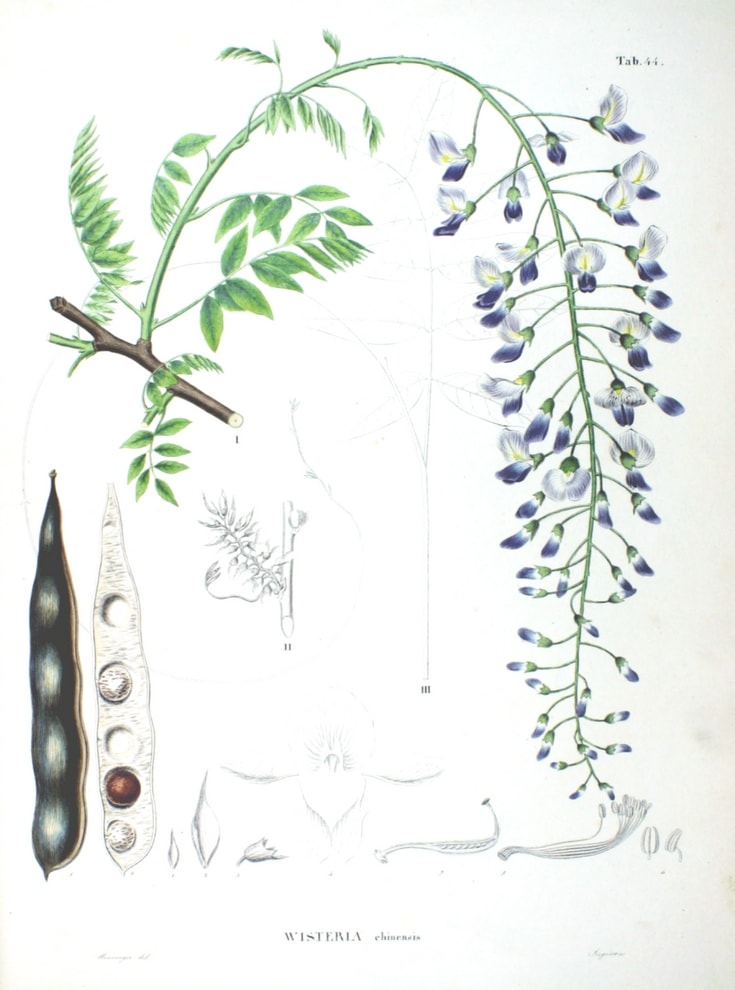
Wisteria, botanical plate
Wisterias offer a spring flowering, from May to June, sometimes as early as April. The flowering of Chinese Wisteria is earlier than that of Japanese Wisteria: it occurs before the leaves appear. Chinese Wisteria (Wisteria sinensis), American Wisteria (Wisteria frutescens), and Wisteria venusta sometimes offer a second flowering in summer. Some species can even, very exceptionally, bloom three times! For this to happen, the climatic conditions must be right.
This stunning climbing plant offers a pleasantly fragrant flowering, in shades of blue, pink, mauve, or white. These are very soft hues that bring romance and lightness. Its long clusters that droop towards the ground give it a lot of elegance! Those of Wisteria floribunda ‘Macrobotrys’ can sometimes reach over a metre long! The plant then appears to be weighed down by a wonderful cascade of flowers. Wisteria venusta produces much shorter clusters, about twenty centimetres long. The flowers of Wisteria are melliferous: they attract bees and butterflies.
The foliage of Wisteria is deciduous. Its compound leaves measure between 15 and 40 cm long and are divided into 10 to 20 leaflets. They are light green when young, darkening during the summer, then turning yellow in autumn before detaching and falling.
The roots of Wisteria are very vigorous and powerful. They spread widely on the surface but do not penetrate deeply into the soil.
After flowering, Wisteria produces large pods about ten centimetres long, resembling those of beans or Cytises. They have little ornamental interest. They contain brown, round, and flat seeds. You can collect them to sow, but you must wait for them to dry and turn brown… and be patient: a Wisteria grown from seed will take many years to flower.
Wisteria is a resilient plant, easy to cultivate and very hardy. It tolerates temperatures of around -15 to -20 °C.
 There are about ten botanical species. The most cultivated are Chinese Wisteria and Japanese Wisteria, for which horticulturists have created many varieties. These botanical species are:
There are about ten botanical species. The most cultivated are Chinese Wisteria and Japanese Wisteria, for which horticulturists have created many varieties. These botanical species are:
Wisteria sinensis
Chinese Wisteria is the most common species in cultivation. Its flower clusters are slightly shorter and denser than those of Wisteria floribunda. It blooms a little earlier in spring, before its leaves appear, and often offers a second flowering during the summer. There is a variety with white flowers: Wisteria sinensis ‘Alba’.
Wisteria floribunda
Japanese Wisteria offers very fragrant flowers that gradually bloom from the top of the cluster downwards. Its clusters are slightly longer and thinner than those of Chinese Wisteria. It also blooms later, allowing the flower buds to escape the last frosts. This is the species to choose if you live in a region with a harsh climate! It only blooms once.
Wisteria venusta
This Wisteria offers a superb fragrant flowering of pure white. Its clusters are short, measuring only about ten centimetres in length. It has beautiful fluffy leaves. Less vigorous than the other species, it is suitable for small gardens and for pot cultivation. Choose it if you are short on space! It establishes quickly and can flower in the year of planting. It is also found under the name Wisteria brachybotrys. It sometimes offers a second flowering in summer.
Our favourite varieties
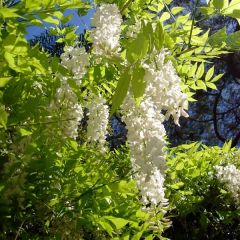
Wisteria sinensis Alba
- Flowering time May, June
- Height at maturity 9 m

Wisteria floribunda Macrobotrys
- Flowering time June, July
- Height at maturity 8 m
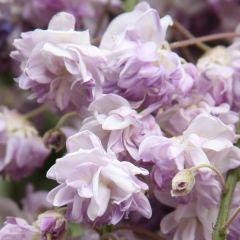
Wisteria floribunda Violacea Plena
- Flowering time June, July
- Height at maturity 10 m
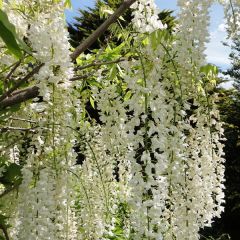
Wisteria floribunda Alba
- Flowering time June, July
- Height at maturity 10 m
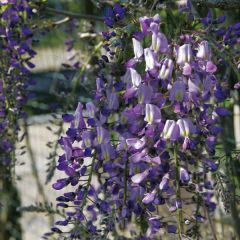
Wisteria floribunda Domino
- Flowering time June, July
- Height at maturity 7 m
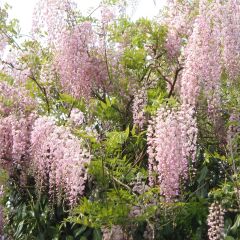
Wisteria floribunda Honbeni
- Flowering time June, July
- Height at maturity 10 m
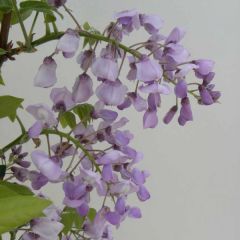
Wisteria venusta Okayama
- Flowering time May, June
- Height at maturity 4 m
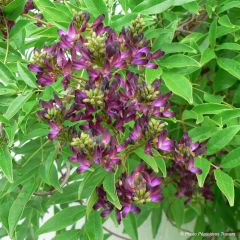
Millettia japonica Satsuma
- Flowering time August to December
- Height at maturity 5 m
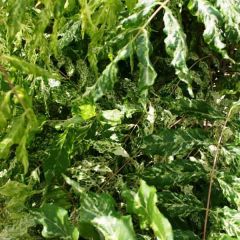
Wisteria floribunda Variegata
- Flowering time June, July
- Height at maturity 10 m

Wisteria venusta Rosea
- Flowering time June, July
- Height at maturity 5 m
Discover other Wisterias
View all →Available in 0 sizes
Available in 0 sizes
Available in 0 sizes
Available in 0 sizes
Available in 2 sizes
Available in 1 sizes
Available in 0 sizes
Available in 1 sizes
Available in 3 sizes
Available in 1 sizes
Planting Wisteria
Where to plant?
Install Wisteria in full sun. It can tolerate slightly shaded areas, but it produces a much more abundant flowering when planted in the sun. Don’t hesitate to place it against a south-facing wall! This position will also protect it from cold northern winds.
It can grow in poor soils, but prefers them rich, cool, and well-drained. Avoid overly heavy or clayey soils! It prefers sandy grounds, which are much better for drainage. If your soil is heavy, we suggest adding gravel or clay balls during planting to prevent stagnant moisture.
It has a preference for slightly acidic soils, and does not like calcareous grounds! These can lead to chlorosis, characterised by yellowing foliage.
Provide a solid and thick support that can withstand it! Remember that Wisteria is a very vigorous plant that, over time, can twist and break supports. Choose to let it climb against a wall, or on a pergola or arbour. If you plant it against your house wall, ensure that its stems do not slip between the tiles of your roof by regularly pruning it and directing its branches in the right direction.
You can also plant it in a large container, which you will place on a terrace. It will then require a bit more attention, more regular watering, and a supply of fertiliser.
→ Discover our advice sheet on 6 climbing plants to grow in pots on a west-facing balcony
When to plant?
Wisteria is ideally planted in autumn or spring. Avoid intervening during frost periods.
How to plant?
Start by finding a solid and sturdy support, preferably made of wood or metal. Let it grow against a wall, in a tree, on a pergola, or an arbour. When planting against a wall, maintain a distance of at least 50 centimetres to prevent it from damaging the wall as it matures.
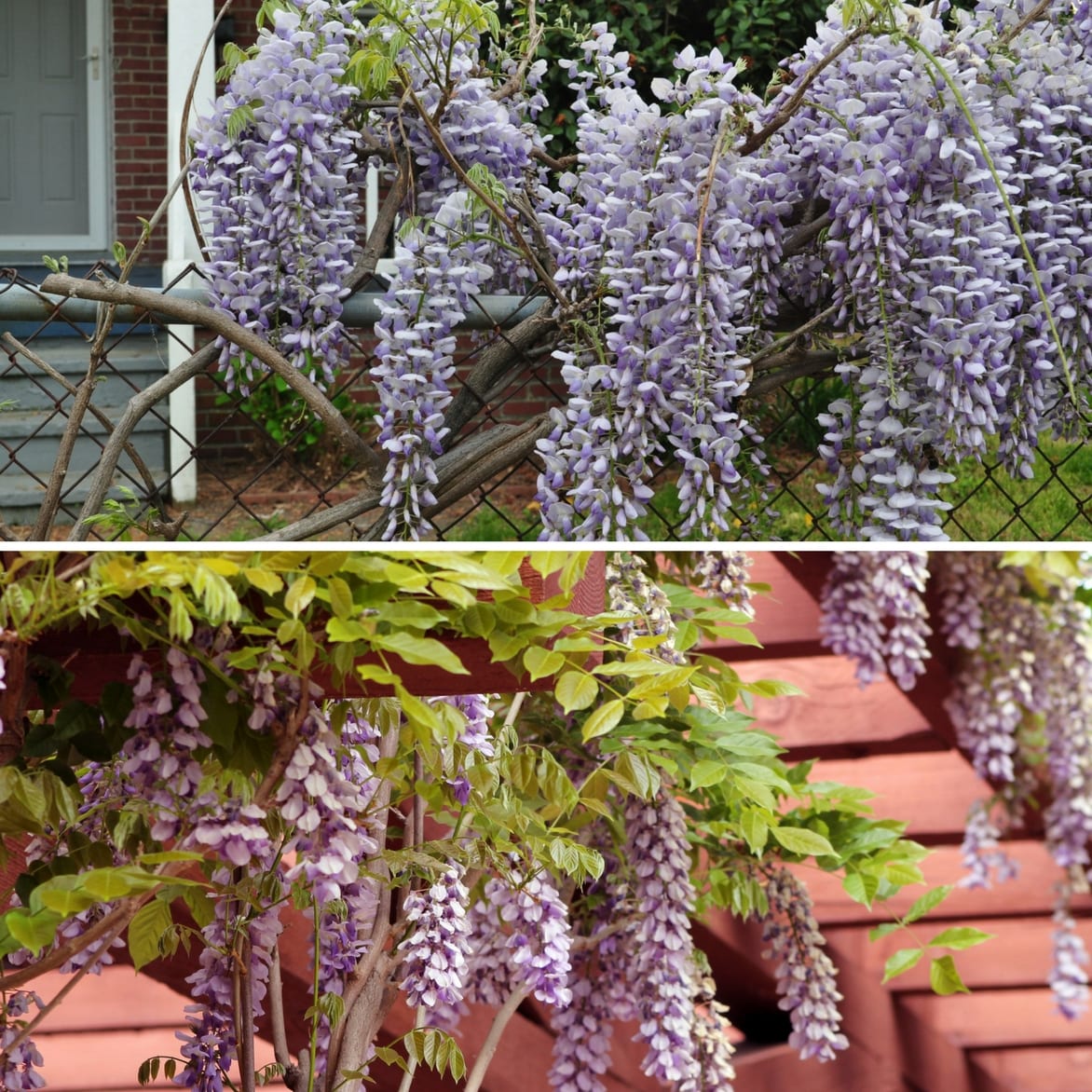
A simple trellis is far too fragile for vigorous Wisteria. Opt for a solid pergola instead!
- Next, soak the root ball in a basin filled with water. This will increase the chances of successful establishment and facilitate later watering.
- Dig a planting hole two to three times larger than the root ball.
- Place clay balls or gravel for drainage and to prevent stagnant moisture.
- Add a few handfuls of compost.
- Plant: place the root ball ensuring not to bury the collar. Replace the soil around the plant. Firm it down to ensure contact between the root ball and the soil.
- Water generously.
- Guide its voluble stems around the support to help it cling.
It needs time to settle in and often requires a few years before flowering. Don’t worry if you don’t see flowers in the first few years.
Caring for your wisteria
Naturally very vigorous, Wisteria does not require fertiliser, unless it is not flowering or if you are growing it in a pot. In this case, always choose a fertiliser low in nitrogen and high in potassium. Otherwise, nitrogen would promote leaf growth at the expense of flowering.
Planted in calcareous soil, Wisteria can suffer from chlorosis, which manifests as discoloration and yellowing of its leaves. If it is still young and possible, move it and plant it in a pot. Otherwise, improve the soil by adding manure or topsoil.
Although resilient, Wisteria is susceptible to aphids, scale insects, armillaria, and leaf spot disease. Attacks from scale insects or aphids may lead to the appearance of sooty mould. This disease, caused by a fungus, covers the leaves with a black layer resembling soot. It is not very harmful to the plant.
We recommend placing a layer of mulch at the base of your Wisteria to keep the soil cool. Water young plants during the first two or three years, as well as Wisteria planted in pots. In other cases, only water in the event of summer drought!
Regularly monitor the growth of your Wisteria and guide its stems in the desired direction by wrapping them around their support. This will prevent them from causing damage, such as slipping under a roof or invading other plants.
How to prune Wisteria?
Vigorous and powerful, wisteria needs to be pruned regularly, ideally every year. It grows quickly and, unless you are cultivating it naturally by allowing it to climb a tree, it is essential to control its growth. This pruning will help you give it a harmonious shape, as well as promote flowering! Otherwise, you will soon find yourself with an unmanageable plant jungle.
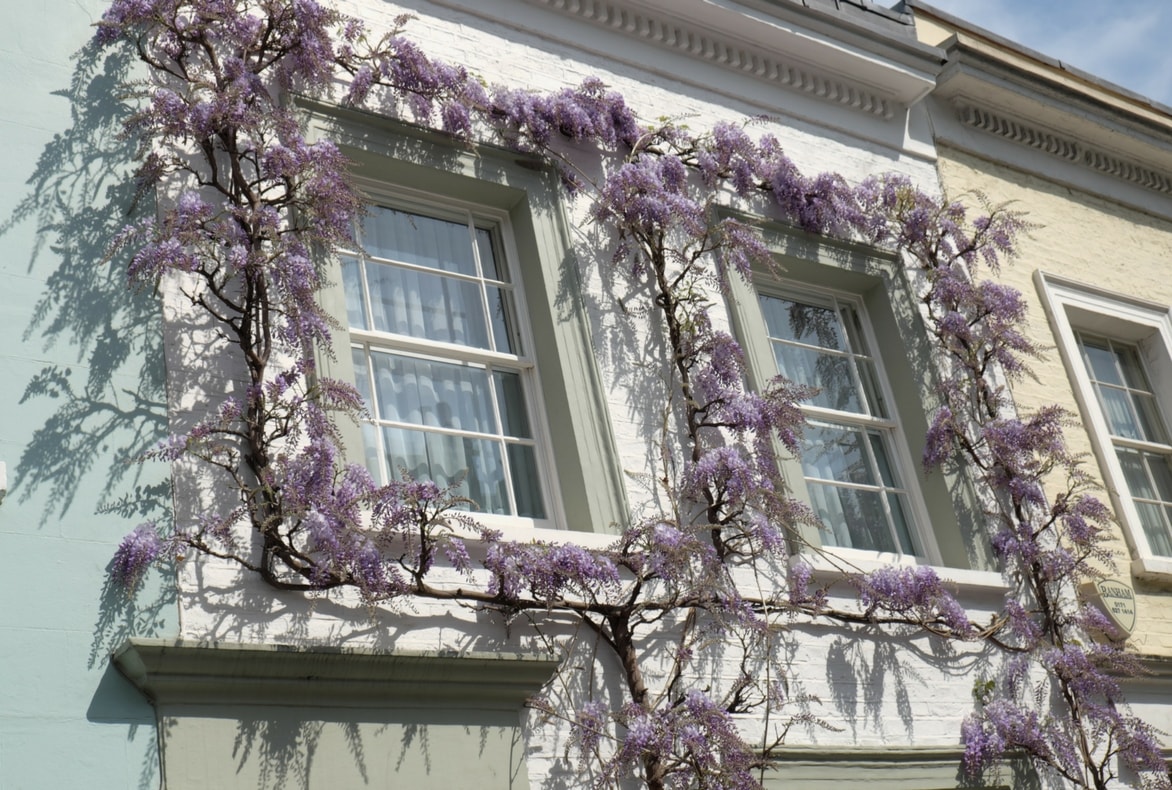
Regularly pruned and trained, this wisteria adds a very chic touch to the facade of this house.
Wisteria can be pruned several times a year. Make each cut cleanly, using pruning shears, just after a bud. Take the opportunity to remove dead, poorly formed, or poorly positioned branches.
- Winter pruning:
This pruning helps to better distribute the flowering, making it more harmonious. Work outside of severe frost periods. Cut the branches that extend outward, leaving only two or three buds each time.
- Spring pruning:
The goal is to achieve a more abundant flowering and more branching. Prune in March or April. Cut the green shoots from the previous year, leaving only four or five buds on each branch.
- Summer pruning:
This helps to control and direct its growth. Cut the stems that are going in the wrong direction, to guide the plant where you want it, and possibly redirect it towards its support. When the shoots are particularly long, shorten them by a third.
It is also possible to train wisteria as a tree. To do this, plant a stake and attach a stem to it. Do not wrap it around the support but simply secure it with ties. Prune it very regularly to remove lateral branches and keep only the tallest ones. Prune these last ones to three or four eyes.
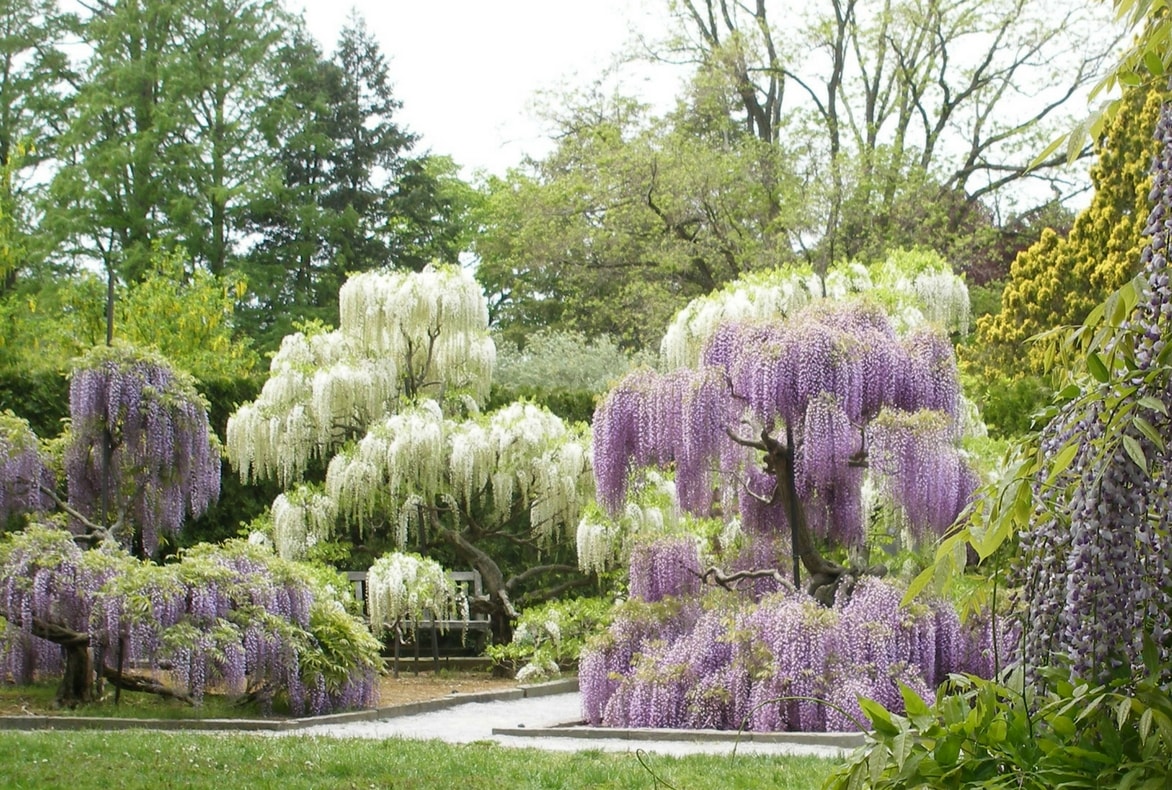
Wisteria (Wisteria) trained as trees in a park
Propagation of Wisteria
Wisteria can be propagated by propagation by cuttings, layering, or grafting. We recommend layering as it is the simplest and quickest technique. Sowing is more challenging, and you must wait at least six years before seeing it flower! Unless you choose Wisteria venusta, which has the advantage of flowering in the first few years.
Layering
You can easily multiply your Wisterias by performing layering by pegging during the summer.
- To do this, choose a long, low, and healthy stem.
- Bring it close to the ground. At this location, loosen the soil, add some potting mix, and dig a furrow. Bend the branch towards the ground, make an incision on the underside of the shoot, remove the leaves in this area, and place the branch in the furrow.
- Cover it with a layer of soil. Hold it in place with a stone or a hook. Raise the end of the branch, straightening it by tying it to a stake.
- Water generously.
Once the layer has developed roots, you can cut the branch to separate it from the original plant. You can then replant it in a pot or place it in its final location.
Sometimes Wisteria layers spontaneously when a stem comes into contact with the ground, so keep an eye out!
→ Learn more about layering Wisteria in our tutorial!
Propagation by Cuttings
Wisteria can be propagated by cuttings after flowering, ideally in June or July.
- Start by preparing a pot: fill it with substrate and water it to moisten it. Take a healthy stem about ten centimetres long.
- Make a clean cut just below a node (the point where leaves attach to the stem). Remove the basal leaves. Replant the cutting in the substrate. Gently firm it to ensure contact between the cutting and the potting mix.
- Place it in a sheltered location with bright light. The substrate should remain moist: remember to water regularly.
And be patient: it will take several years before you see it flower.
Grafting
Graft Wisteria in late winter or early spring, between March and April. We recommend the simple English grafting technique, using a Chinese Wisteria as the rootstock. Grafting is more complicated than layering or propagation by cuttings, which is why we suggest multiplying your Wisterias by layering instead.
- Select a scion of the same diameter as the rootstock, ideally the size of a pencil.
- Cut the rootstock about twenty centimetres above the collar with pruning shears. Trim both the scion and rootstock at an angle, using a sharp grafting knife: maintain an angle of 20 to 30°, about 3 centimetres long.
- Place the two parts together and bind them with an elastic band. You can apply grafting wax to promote healing. Water.
If you see suckers growing below the grafting point, remove them.
Association
Given its exceptional vigour, associating Wisterias with other plants is always delicate. Care must be taken not to plant it too close to other species and to pair it with vigorous plants. Otherwise, it may take over and smother them!
When grown on an arbour, pergola, or against a wall, you can pair it with other climbing plants: Rambling Roses, Clematis, Trumpet Creepers… And, of course, with other varieties of Wisteria: white, blue, mauve, or pink flowers, and Millettia japonica. Feel free to mix the varieties!
With its gentle flowering, Wisteria is a perfect plant for creating a romantic atmosphere! You can plant it at the back of a small bed of perennials and grasses. It will add height to the arrangement. At its base, install Delphiniums, Dianthus, Allium, or Stipa, accompanied by a few small bushes like Ceanothus. For more ideas, draw inspiration from this delightful romantic atmosphere.
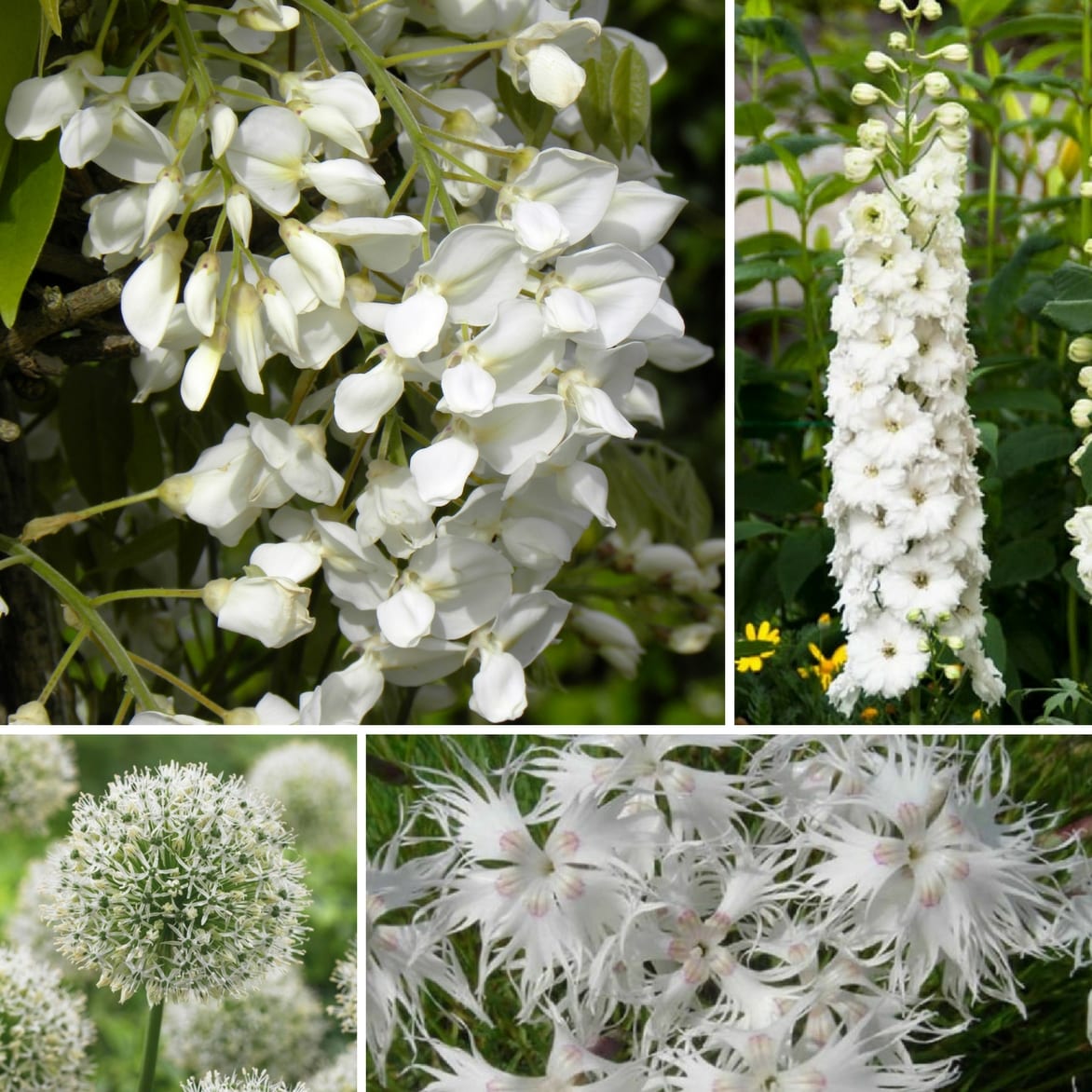
A charming association for a white garden: Japanese Wisteria (Wisteria venusta), double Innocence Delphinium elatum, Allium stipitatum Album, and Dianthus arenarius
You can also make it climb in a tree! Provided you choose a large, healthy, and vigorous specimen, for example among beeches or oaks. Your tree will then offer a surprising spectacle in spring, covered in blue, mauve, or white flowers.
Wisteria boasts such an impressive flowering that it is stunning when planted in isolation. Don’t hesitate to prune it into a tree by placing it, for instance, in the middle of a short grass meadow. Its brilliant flowering will be even more highlighted!
Did you know?
- Bonsai Wisterias!
As Wisteria is easy to cultivate, responds well to pruning, and is very vigorous, it can be pruned into a bonsai! It produces stunning miniature trees. Preferably choose species with short clusters: they will have a more harmonious and balanced appearance. Wisteria frutescens or Milletia japonica are very suitable for this purpose!
- Pruning Record!
A gigantic Wisteria in Sierra Madre, California, covers nearly 4,000 square metres! It is recorded in the Guinness World Records. Planted in 1892, it is now one of the largest climbing plants in the world.
- A stroll under cascades of flowers!
In Japan, the Kawachi Fuji Garden is renowned for its two long arched walkways, measuring 220 and 80 metres in length, which are completely covered in Wisteria flowers in April and May! There are nearly 150 young plants, gathering around twenty different species. Imagine strolling through this garden, under a sky adorned with thousands of flowers with an enchanting fragrance!

A tunnel of 150 wisterias in the Kawachi garden – Kukuoka – Japan – Source: pauldingcountyareafoundation.net
Useful resources
- Discover our wide range of Wisteria!
- Advice sheet: Wisteria: how to train and prune it
- Advice sheet: Choosing your wisteria
- Advice sheet: Growing wisteria in a pot
- Advice sheet: 5 very hardy climbing plants
- Advice sheets: the 6 most beautiful wisterias, 5 perpetual wisterias; 5 wisterias to grow in pots
- Advice sheet: How to associate a wisteria?
- Tutorial: When and how to cut back a wisteria?
Frequently asked questions
-
My Wisteria isn't flowering, or very little! What should I do?
It's one of the most common problems! If you have recently planted it, be patient as it takes time to settle in. It can sometimes take two to three years before it starts flowering. And if it is from sowing, you will need to wait at least six years!
However, check that the exposure is suitable. It needs plenty of sunlight to flower! If it is placed in shade or partial shade and is not flowering, consider moving it.
If it is Chinese Wisteria (Wisteria sinensis) and you live in a region with a harsh climate, where there are late frosts, it is possible that its flower buds have frozen! Instead, opt for Japanese Wisteria (Wisteria floribunda), which flowers a little later in spring.
Avoid overly rich soils or excess nitrogen fertilisers: they promote leaf growth at the expense of flowers! Instead, you can provide a fertiliser rich in potassium.
To encourage its flowering, regularly prune your Wisteria, and do not neglect the spring pruning. By reducing the vigour of its stems, the Wisteria will concentrate its energy on flowering. The flower buds will be directly nourished by the sap.
-
Can I plant a Wisteria in winter?
Yes, planting is possible in winter when the plant is in a dormant state, provided that you act outside of severe frost periods.
-
Can this climbing plant be grown in a container?
Yes, but preferably choose Wisteria venusta or Wisteria frutescens! Less vigorous, they have reduced growth compared to Chinese or Japanese Wisteria. Choose a pot that is large enough and drain the bottom with gravel or clay balls. A Wisteria in a pot will require more watering and fertiliser than those planted in the ground. Always opt for fertilisers low in nitrogen but rich in potassium and phosphorus.
-
The leaves of my Wisteria are discolouring and turning yellow! What should I do?
The foliage of Wisteria is deciduous, turning naturally yellow in autumn. However, if it turns yellow at another time of year, it is likely that your Wisteria is suffering from chlorosis. This indicates that the soil is too chalky! The high pH blocks the absorption of mineral elements by the plant, which then becomes deficient. To determine the nature of your soil, you can purchase a soil analysis kit at a garden centre. If it is still young, we suggest you dig up your Wisteria and plant it in a container. Otherwise, improve your soil by adding organic matter (compost, manure) or topsoil. Also, avoid watering with overly chalky water; prefer rainwater.
-
- Subscribe!
- Contents
































